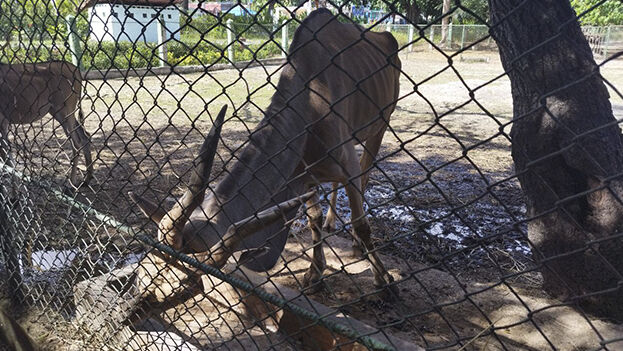
![]() 14ymedio, Juan Diego Rodríguez, Havana, 23 November 2022 — The scenario at the 26th Avenue Zoo in Havana, a year after it reopened its doors after the forced closure due to the COVID-19 pandemic, is more depressing than ever. Malnourished animals, without water, with their pens full of dirt and excrement, are the general trend, as attested to on Tuesday by 14ymedio.
14ymedio, Juan Diego Rodríguez, Havana, 23 November 2022 — The scenario at the 26th Avenue Zoo in Havana, a year after it reopened its doors after the forced closure due to the COVID-19 pandemic, is more depressing than ever. Malnourished animals, without water, with their pens full of dirt and excrement, are the general trend, as attested to on Tuesday by 14ymedio.
“The only thing that grows here are the African snails,” summarized a young man who was visiting his partner when he saw the exemplary numbers of that plague that arrived in Cuba a few years ago.
The conditions of the place, which in recent days have been denounced again on social networks, have definitely earned it a bad reputation. “There are very few people, very few children, despite it being a week of school break,” said another woman, who also complained about the high prices of food in the kiosks. Easily, people spend 700 pesos “for nonsense.” Most only manage to buy a frozen fruit.
Despite the fact that at the entrance of the zoo there is a warning that it is out of service, the train works, although a manager travels on board and gets off to push it when it runs out of fuel. Nor do the attractions for children or the electric cars work well, which barely run with their flat tires and tarpaulin covers to disguise the deterioration of the tires.
Skinny and barely moving, the leopard was moaning in his pit, which had no water. The skin of lions, which used to attract visitors more easily, is full of pustules and flea bites. All of them, just like the antelopes, have ribs showing and tired eyes. “The only ones that are well fed are the monkeys, because there are a lot of bananas, and they’re cheap,” said another visitor.
The bear area has been infested by colonies of the African giant snail, an invasive species that raised alerts on the Island as a potential risk to human health, since they carry parasites that can cause diseases such as meningoencephalitis and abdominal angiostrongiliasis. Cuba faced an outbreak of this dangerous mollusc between 2018 and 2019, but work to eradicate it was cut short in 2020 with the arrival of the pandemic.
Translated by Regina Anavy
____________
COLLABORATE WITH OUR WORK: The 14ymedio team is committed to practicing serious journalism that reflects Cuba’s reality in all its depth. Thank you for joining us on this long journey. We invite you to continue supporting us by becoming a member of 14ymedio now. Together we can continue transforming journalism in Cuba.
